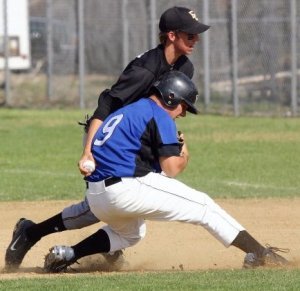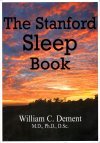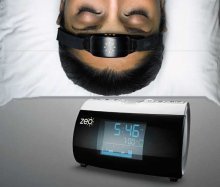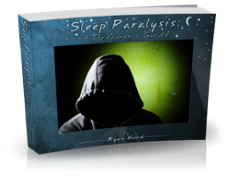
| Connect & Subscribe |
Lucid Dreaming and Athletics: The Dreamer's Advantage
Written by Kaia Simmons, Spring 2010Conditioning, drills, strength training, and proper nutrition--these are all familiar avenues by which athletes try to improve. As every athlete knows, the quest for "that extra edge" over the competition is a perpetual aspect of competitive sports.
 Lucid dreaming allows you to do pretty much anything you can DREAM up, including training for your sport.
Lucid dreaming allows you to do pretty much anything you can DREAM up, including training for your sport.
One must remember, however, that life is composed of two parts: wakefulness and sleep (Dement). Those who look to improve their athleticism with only the aforesaid steps are limiting their efforts to their wakeful hours. In fact, the hours an athlete spends asleep can be just as conducive to his or her athletic improvement.
Yes, sleep provides the body rest and recovery, but it can also allow the athlete to practice his physical and mental skills in an ideal environment of his own creation. How might such a thing be possible? In two simple words: lucid dreaming.
Lucid dreamers are able to control their dreams. In lucid dreams, the dreamer becomes aware that he or she is dreaming and, from that knowledge, can manipulate the dream at will.
Are you starting to see how this could be an extremely effective tool for honing skills? For athletes, the implications include extra time to be used for perfecting sensory-motor movements and mental preparation before competition. We'll get more specific with these implications in a bit, but first let's make sure we're crystal clear on some important aspects of lucid dreaming.
Lucid dreaming is an "altered state of consciousness" (Dement 271) that differs from ordinary dreaming in that the dreamer is capable of judgment and reflection, thereby utilizing more awareness than he or she would in ordinary dreaming.
More Articles On Lucid Dreaming
What Is Lucid Dreaming? Foundation Article
Inception's Dream Time & An Awesome (Conflicting) Lucid Dreaming Experiment
Master Of The Dream World: How The Lucid Dreamer Turns Fantasy Into Reality
It occurs during REM (Rapid Eye Movement) sleep--the sleep phase so named because of the sleeper's frequent, rapid eye movements. During REM sleep, the brain remains highly active even though certain motor neurons in the brain stem are suppressed in order to paralyze the sleeper's body (Dement).
This combination of an active brain and inactive body distinguishes lucid dreaming from wakeful imagery or visualization, for although the body's muscles are actively inhibited in REM sleep, the neural messages sent to them in dreams can be just as strong as when the body is awake (LaBerge 116). Therefore, in certain aspects, activity in lucid dreams can be nearly as effective at honing physical skills as activity in waking life can be.
Furthermore, while ordinary dreams are often forgotten, memory of lucid dreams appears to be equal to memory of waking life (Dement 275), thereby allowing the athlete to apply his dream experiences to the waking world more easily.
Motor Skill Training
Lucid dreaming is a great way for an athlete to work on his or her skills, for "imagery rehearsal may work to improve motor skills by strengthening the neural pathways used to elicit the patterns of movement that are required by the skill" (LaBerge 116). Dr. Stephen LaBerge, eminent authority on the study of lucid dreaming, calls this mechanism "cognitive coding" (LaBerge 116), in which the individual makes a conscious map of the skill and its execution.
Lucid dreams are such a great venue for this mapping because the dream world is less reliant on sensory information and sensory processes than the waking world. As a result, the dreamer has greater license to create the setting of her choosing, thereby preventing her and her intended actions from being distracted by the sensory world around her. This can help an athlete perfect sensory-motor skills that she is already somewhat familiar with, for it provides her with a distraction-free practice arena in which she can direct her attention solely towards the skill itself. Like in the waking world, repetition of such execution reinforces the "muscle-memory" (LaBerge) of the activity, thereby helping the athlete to improve her motion.
Lucid dreaming can also help athletes learn entirely new actions. Athletes can "practice performing movements for which their bodies are not yet physically prepared, setting up neural and mental models for skills so that the movement models will be ready when the muscles are" (LaBerge 116).
Improvements in these new skills may become evident before the athlete even attempts them in the waking world, for positive changes in a technique are often even observed from dream to dream. Thus, the sleeper's dexterity in the dream world improves with practice just like it would in the waking world.
This effect is particularly evident in the study of supernatural dream behaviors such as flying, for while the skills required for flight are not applicable to the waking world, the dreamer can still exhibit the same progression towards mastering the action: practice, repetition, and gradual improvement.
Mental Training
Along with sensory-motor skills, lucid dreaming allows for mental training that can be just as beneficial for athletes. Its effectiveness is due to largely the same reason: the ability of the dreamer to craft his own world, excluding distraction and allowing for utmost focus. As a result, lucid dreaming can help an athlete reduce any performance anxiety that may be present and gain confidence for situations that may come up in real games.
Performance anxiety can be lessened because, in dreams, people are able to "let go of anxiety about the audience because they know it is not composed of real people" (LaBerge 120), thereby training them to perform in front of people without letting it interfere with their performance. The dreamer can even envision a range of possible scenarios, allowing him to practice reacting to adverse situations.
Confidence can be increased because the dreamer has greater freedom to do what he might find impossible in the waking world. While ordinary dreams may still reflect an athlete's observations of the waking world--what he perceives he can and cannot do--lucid dreaming gives the dreamer the potential to "consciously create new models" (LaBerge 122) because he knows he is not in the waking world. As a result, the athlete's potential capabilities are greatly expanded, allowing him to "safely test new behaviors" (LaBerge 122) and develop the confidence to perform the same behaviors while awake.
How To Do It - Train Yourself
Despite its great value and effectiveness, lucid dreaming is not widely used as a performance-enhancing tool among athletes. Its benefits are not well known and the ability to dream lucidly is largely not inherent. While some dreamers attest to having frequent lucid dreams, many have never experienced one.
Fortunately, one does not have to be a natural lucid dreamer to experience lucid dreams. People can learn how to dream lucidly and train themselves to do so in a way that can help their performance in real life.
Training yourself to lucid dream first involves working on your dream recall. Having a stronger dream recall is key to increasing your chances of becoming cognizant. From there it's largely a matter of effort--going to bed each night with the intention to become lucid and your dream. There are also a good number of strategies that highly experienced lucid dreamers use to cue themselves that they are dreaming.
There's even a lucid dreaming mask that LaBerge has developed that detects when you're in REM sleep so it can flash red lights over your eyelids, which can manifest themselves in your dream to give you the cue you need to realize you're dreaming.
You can learn all the most effective strategies straight from the most experienced lucid dreamer himself by reading Dr. LaBerge's book Exploring The World Of Lucid Dreaming, pictured at right. In the meantime before you read the book, we'll discuss a few key concepts below.
The two most common ways dreamers become lucid: Lucid dreams can be dream initiated, whereby something in the sleeper's dream indicates that it is a dream, or wake initiated, whereby the sleeper awakens briefly during REM sleep before quickly returning to it, the disruption often triggering lucidity (LaBerge).
In addition to understanding this, it is key that the sleeper also learn to perform reality tests while dreaming in order to determine whether he is in the dream world or the waking world, for once he recognizes he is in the dream world, he can begin to construct his own dream. This is exactly what the dream mask mentioned above is about.
Again, it takes great practice for one to learn to master one's own cognition while sleeping, but with repetition the skill becomes easier, and with the right strategies and and effort anyone can do it.
You can find out a bit more about how you can learn to lucid dream from our site here.
Or check out experienced lucid dreamer Rebecca Turner's list of the most effective lucid dreaming techniques, along with some phenomenal articles to explain each one.
Lucid dreaming can provide an athlete with that "extra edge," both physically and mentally. Not only is the sensory-motor work and mental strengthening that can occur during sleep incredibly beneficial, but an athlete who trains in his sleep and waking life has the potential to devote a significantly greater number of hours his sport than any of his competition who do not harness the skill of lucid dreaming.
Furthermore, "the act of creating a concrete mental image in which we see ourselves as happy, or successful, reinforces our intentions to behave in ways that help us achieve the image in our heads" (LaBerge 123). Lucid dreaming can be far superior to wakeful visualization techniques and has the potential to become a tremendous aid to athletes, although its merits are still not widely known. An increased awareness of its benefits could lead to a great rise in its popularity within the athletic world.
What do you think? We would love to hear your thoughts about lucid dreaming in athletics and you can share them with us below. You can also share this page with your friends using these buttons:
Are You An Athlete Who Wants To Lucid Dream?
What do you think about how lucid dreaming can help you with your athletic performance? Do you have any questions or stories about your experiences? Share any comments or questions you have with us below!
Read Other Thoughts About Lucid Dreaming and Sports
Click on the links below to read other stories, thoughts, and questions about lucid dreaming and sports. They were all written by other visitors to this page, just like you.
Train All Night and Don't Lose a Wink of Sleep
I started gymnastics a little late... when I was 9. And my first gym was good for beginners that are just being introduced to gymnastics, but not for people …
Works Cited & Additional Resources
Dement, William C. "Sleep and Dreams Lecture." Stanford University. Cubberley Auditorium, Stanford. 29/03/2010. Lecture.
Dement, William C. The Stanford Sleep Book. 2002. Print.
LaBerge, Stephen. Exploring the World of Lucid Dreaming. New York: Ballantine Books, 1990. Print.
LaBerge, Stephen. "Lucid Dreaming." Sleep and Dreams. Stanford University. Cubberley Auditorium, Stanford. 26/04/2010. Lecture.
Tholey, Paul. "Applications of Lucid Dreaming." SpiritWatch. Johann Wolfgang Goethe Universitt, Germany, n.d. Web. 14 May 2010.
About This Site
Welcome! This site is continuously being created by students of Dr. William C. Dement's Sleep And Dreams course at Stanford University.
We made this site as a call to action for people all over the world to live healthier, happier, safer, and more productive lives by learning about their own sleep. We have faith that reading the information provided on this site will motivate you to be smart about your sleep deprivation and strategic about your alertness in order to live life to your fullest, most energetic potential.
In fact, we challenge you to do so! What do you say, are you up for the challenge?
Interviews With Sleep Specialists: Insights Into the Worlds of Sleep Medicine & Sleep Business
America's Most Dangerous Disorder: What Is Sleep Apnea Doing To Your Sleep?
Sleep Debt: How Much More Will You Achieve When You Reduce Yours?
The Stages Of Sleep: The Journey Through The Night
Delayed Sleep Phase: You Want To Sleep But You're Not Tired Yet
Paralyzed at Night: Is Sleep Paralysis Normal?
Sleep In Words: Smart, Strange, and Funny Quotes About Sleep
Sleep Disorders In Children: What's Keeping Your Child From A Full Night's Rest?
Attacks of Pavor Nocturnus (a.k.a. Sleep Terrors, Night Terrors, or Incubus Attacks)
The Stanford Sleep Book
Dr. Dement's pioneering textbook has been the core text for Sleep and Dreams since 1980, but it has just recently been made available to the wider public for the first time.
In it you'll find a more detailed account of the most important things you need to know about sleep, alertness, dreams, and sleep disorders. Studies, statistics, plus plenty of Dr. Dement's classic anecdotes painting the history of sleep medicine.
Preface | Intro | Contents | Get A Copy
More Sleep Resources
The Zeo
A revolution in personal sleep tracking, the Zeo is a wireless headband that transmits your brainwaves in realtime to a dock (pictured here) or your smartphone. The result? You can wake up and see exactly what stages of sleep you were in during the night! Unprecedented personalized sleep knowledge.
Sleep Paralysis: A Dreamer's Guide
Ever woken up paralyzed? A surprising number of us have, believe it or not. But few know the actual causes of this phenomenon, and fewer still how to exert control over it. Dream researcher and sleep paralysis expert Ryan Hurd shares breakthrough insights into how to do just that.
Important Disclaimer
Please Note:
The information found on this page and throughout this site is intended for general information purposes only. While it may prove useful and empowering, it is NOT intended as a substitute for the expertise and judgments of healthcare practitioners.
For more info, see our
Terms of Use.
How did we make this website?
Looks like magic, right?

You can learn how to make a great website too. Find out how!










